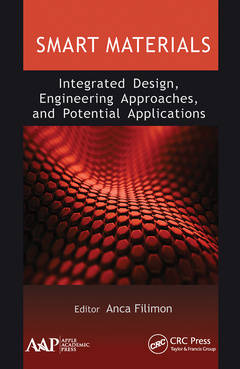Description
Smart Materials: Integrated Design, Engineering Approaches, and Potential Applications
Coordinator: Filimon Anca
Language: English
Subjects for Smart Materials: Integrated Design, Engineering...:
Keywords
Bone Tissue Engineering; Smart Material; Pva Hydrogel; Tissue Engineering; Polymer Surfaces; PVA Matrix; Ion Beam; MMT Nanocomposite; Cyclodehydration Reaction; Porogenic Agent; Model Compound; CO2 Capture; Amphiphilic Polymers; Xanthan Chains; LDH; Cellulose Ethers; Smart Materials; Plasma Treatment; Colesevelam Hydrochloride; PVA Film; Polymer Vesicles; Porous Microparticles; Molecular Imprinting; UV Treatment; Bacterial Cellulose
Publication date: 03-2021
Support: Print on demand
Publication date: 09-2018
· 15.2x22.9 cm · Hardback
Description
/li>Contents
/li>Biography
/li>
Polymer-based smart materials have become attractive in recent years due to the fact that polymers are flexible and provide many advantages compared to inorganic smart materials: they are low cost, they are easy to process, and they exhibit good performance at nano- and microscale levels.
This volume focuses on a different class of polymers that are used as smart materials in the areas of biotechnology, medicine, and engineering. The volume aims to answer these questions: How do we distinguish ?smart materials?? and How do they work? The chapters lay the groundwork for assimilation and exploitation of this technological advancement. Four of the key aspects of the approach that the authors have developed throughout this book are highlighted, namely the multidisciplinary exchange of knowledge, exploration of the relationships between multiple scales and their different behaviors, understanding that material properties are dictated at the smallest scale, and, therefore, the recognition that macroscale behavior can be controlled by nanoscale design.
Impact of Smart Structures on Daily Life: An Alternative for Progress toward Revolutionary Discoveries. Engineering Smart Polymeric Materials with Complex Architectures for Biomedical Applications. Strategies to Improve the Xanthan Properties for Specific Applications. Amphiphilic Polymers Designed for Biomedical Applications. Self-Assembly in Solution of Metal Complexes Based on Organo-Siloxane Ligands. Porous Particles as Smart Materials for Biomedical Applications. Aminosilicones as Active Compounds in the Detection and Capture of Co2 from the Environment. Smart Behavior of Cellulose Materials in Pharmaceutical Industries. Recent Research on PVA-Clay Nanocomposites for Targeted Applications. Surface Engineering of Polymeric Membranes. Design of Biologically Active Polymer Surfaces: Cationic Polyelectrolytes as a Multifunctional Platform to Prevent Bacterial Attachment. Biomimetic and Smart Biomaterials for Orthopedic Applications: More than the Sum of Their Components. Quantum Chemistry Simulations: A Computational Tool to Design and Predict Properties of Polymer-Based Smart Systems.
Anca Filimon, PhD, is a Scientific Researcher in the Department of Physical Chemistry of Polymers at the “Petru Poni” Institute of Macromolecular Chemistry, Iasi, Romania, of the Romanian Academy. She has authored over 30 papers for peer-reviewed journals and has written several books and book chapters (as author or co-author). She has participated at national and international conferences (as author and/or speaker), has led several research projects, and has acted as reviewer of several prestigious scientific journals. She is a member of the Romanian Society of Chemistry and of the Romanian Society of Rheology. Dr. Filimon’s scientific contributions are situated at the interdisciplinary interface of polymer chemistry, physics, and biochemistry, and include theoretical and experimental substantiations of the processes and technologies at nano-, micro- and macroscales. Her research is focused on the development of new strategies to achieve the complex architectures with well-defined functionality and various applications. The traditional synthesis tools, new theoretical and experimental physico-chemical approaches, surface science, and biopolymer engineering are combined to realize the design of targeted materials. She earned her PhD in chemistry from the Romanian Academy, “Petru Poni” Institute of Macromolecular Chemistry, Iasi, Romania.
These books may interest you

Nanosensors for Smart Manufacturing 231.50 €



